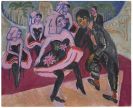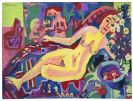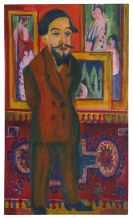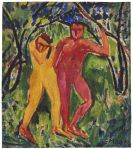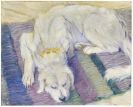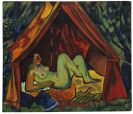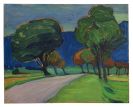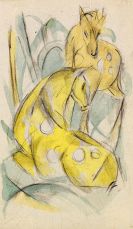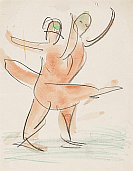
Cesar Klein
Hamburg
1876 -
Pansdorf/Lübeck
1954
At his father's persistent urging, Cesar Klein served an apprenticeship as a painter before attending the Hamburg School for the Applied Arts from 1894. Later he also attended the Düsseldorf Art Academy and the school attached to the Berlin Applied Arts Museum.
From 1900 the artist lived in Berlin, where he had his first successes with illustrating books, making stained-glass windows and murals. The paintings of this early period reveal the influence of Cézanne and the French Impressionists. In 1910 he was among the twenty-seven artists eliminated by the jury from the "Berlin Secession" who went on from there to found the "Neue Sezession" ["New Secession"]. By about 1912 Klein had developed an Expressionist style of his own in which his intensive preoccupation with Cubism soon became palpable.
With time Cesar Klein would come to study the work of Picasso in all that painter's stylistic phases, the reflections of which would crucially shape his own style. In 1918 Klein was a co-founder of the "Novembergruppe" ["November Group"] and was active in the "Arbeitsrat für Kunst" ["Workers' Council for Art"]. From 1919 he taught mural and ceiling painting at the school attached to the Berlin Applied Arts Museum.
Klein often showed work at exhibitions during the 1920s, was a successful scene-painter and decorated several Berlin theatres. However, this extraordinarily prolific and successful period of his career came to a sudden end in 1933. Suspended from his professorship, Cesar Klein was forbidden to paint and lived from 1935 in retirement in the rural seclusion of Pansdorf near Lübeck. He was defamed as "degenerate" in 1937 at the notorious Munich exhibition of works proscribed by the National Socialists.
After the second world war, the artist further developed the swinging rhythm characteristic of what would be increasingly abstract forms, attaining shortly before he died an entirely non-representational style. Publicly acclaimed at numerous exhibitions of his work, he was the first German artist to be shown in London after 1945.
Would you like to sell a work by Cesar Klein?
Infos for seller
